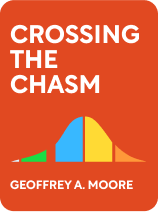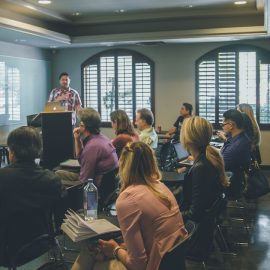

This article is an excerpt from the Shortform book guide to "Crossing the Chasm" by Geoffrey Moore. Shortform has the world's best summaries and analyses of books you should be reading.
Like this article? Sign up for a free trial here .
What is Geoffrey Moore’s book Crossing the Chasm about? How does remaining in the chasm between the early market and the mainstream market sabotage your business?
In his book Crossing the Chasm, marketing consultant Geoffrey Moore explains why most high-tech products stagnate and die out, never reaching the stage of mass adoption. His explanation is grounded in the “Technology Adoption Life Cycle” (TALC), which predicts how innovations are adopted by different segments of society as a technology matures.
Below is a brief overview of Crossing the Chasm by Geoffrey Moore.
The Technology Adoption Life Cycle
Periodically, a new high-tech innovation will transform the way we live or do business and propel its inventors to wealth and fame. In his book Crossing the Chasm, Moore argues that there’s a little-recognized gap or “chasm” in this model between the early market and the mainstream market—and failure to cross this gap accounts for the failure of many high-tech products.
To understand Moore’s strategy, you need to understand the chasm between the early and mainstream markets, and to understand the chasm, you need to understand the Technology Adoption Life Cycle (TALC), also referred to as the “diffusion of innovations.”
As Moore explains, the TALC predicts that as a technology matures, the number of potential new buyers first increases (as the technology starts to catch on) and then decreases (as you run out of potential customers who haven’t already bought it), following the profile of a bell curve. The area under the curve represents the total number of customers for the new technology. This area is divided into five categories of prospective customers, as shown in the figure below.
(Shortform note: This concept was originated by George Beal and Joe Bohlen of Iowa State College, who, in 1956, published studies on when farmers adopted new agricultural technologies (such as fertilizer and hybrid seed corn). Six years later, a communications professor at Ohio State University named Everett Rogers expanded upon Beal and Bohlen’s research in a book titled Diffusion of Innovations, which popularized the concept outside of the farming community and made it relevant to other industries.)
(Shortform note: Moore states that the boundaries between these five categories lie approximately at the standard-deviation intervals on the bell curve. However, the graph that he presents in his book Crossing the Chasm depicts the boundaries further from the center than the standard deviation intervals would be. Moore provides no explanation for this, so presumably his graphic simply wasn’t drawn to scale. However, in our figure above, the boundaries are marked at the standard-deviation intervals.)
Psychographic Categories of Customers
The TALC model divides customers into five categories based on their “psychographics,” the combination of psychology and demographics that dictates their purchasing behavior. These categories are:
- Innovators are the first to buy new technology. According to Moore, they love new technology just because it’s new technology, but they’re often on a limited budget because they usually work highly technical jobs, rather than positions in upper management.
- Early Adopters are the second group to buy new technology. According to Moore, early adopters are usually visionary business managers: They don’t value new technology for its own sake, but they have enough technical insight to identify the strategic advantages that new technology can provide.
- The Early Majority are the third group to adopt new technology. According to Moore, they are pragmatic people, who are interested in leveraging new technology to improve their business, but also averse to the risks of unproven technologies. They are less technically inclined than innovators or early adopters, and tend to measure a high-tech product more by industry standards and the product’s reputation than by direct assessment of the underlying technology.
- The Late Majority are the fourth group to adopt new technology. According to Moore, they are more conservative and less technically competent than the early majority: They’re not interested in getting ahead with technology, but they don’t want to fall behind.
- Laggards do not adopt new technology willingly. If they adopt it at all, it will be old technology by the time they do.
The Gaps in the Technology Adoption Life Cycle
Now that we’ve discussed the TALC, we can discuss the weakness of the model that gives rise to Moore’s “chasm”.
Moore explains that the traditional TALC assumes sales to the five categories of customers transition seamlessly from one to the other as the technology matures. However, according to Moore, this assumption is wrong. He argues that the psychographic differences between the people in each stage of adoption create gaps between each category. Thus, Moore proposes a “Revised TALC,” which recognizes those gaps, as shown below.
| Distinct Gaps Versus Overlapping Populations In Moore’s revised TALC, the categories are shown as separate blocks of a segmented bell curve. However, given that Moore acknowledges you may sometimes be making sales to more than one category at once, a more accurate graphical representation of Moore’s model might represent the categories as individual, overlapping bell curves, as shown below. |
The Chasm
By far the largest gap in Moore’s revised TALC is between the early adopters and the early majority. He refers to this gap as the “chasm.”
Moore explains that early adopters assess new technology at a technical level, to determine if it can give them a strategic advantage, whereas the early majority assess it based on its reputation and standardization. Because they value different things, the early majority won’t look to the opinions of early adopters when deciding whether to buy your product.
This creates a catch-22, because the early majority won’t buy your product until it has built up a good reputation in their industry, but your product can’t build up a good reputation until they start buying it and using it.
(Shortform note: Beal and Bohlen didn’t identify the chasm or discuss this catch-22 of innovation diffusion, but you can see the basis for it in their original paper: The early majority can’t afford to take risks on unproven technologies, but a new technology can’t be widely proven until they adopt it.)
The Early Market and the Mainstream Market
Moore defines the “early market” as the portion of the market made up of innovators and early adopters, and the “mainstream market” as the remaining portion of the market on the other side of the chasm.
(Shortform note: In business, the term “early market” is used mostly in this sense, and most business dictionaries cite Moore’s book as the source of the term. The term “mainstream market,” however, is also used by others to refer to any large or broadly distributed market, in contrast to a “niche market,” which is smaller and more tightly connected.)

———End of Preview———
Like what you just read? Read the rest of the world's best book summary and analysis of Geoffrey Moore's "Crossing the Chasm" at Shortform .
Here's what you'll find in our full Crossing the Chasm summary :
- An explanation of the chasm phenomenon that many new high-tech products face
- How to pilot a product across this chasm to mainstream success
- The problems with the Technology Adoption Life Cycle (TALC) model






